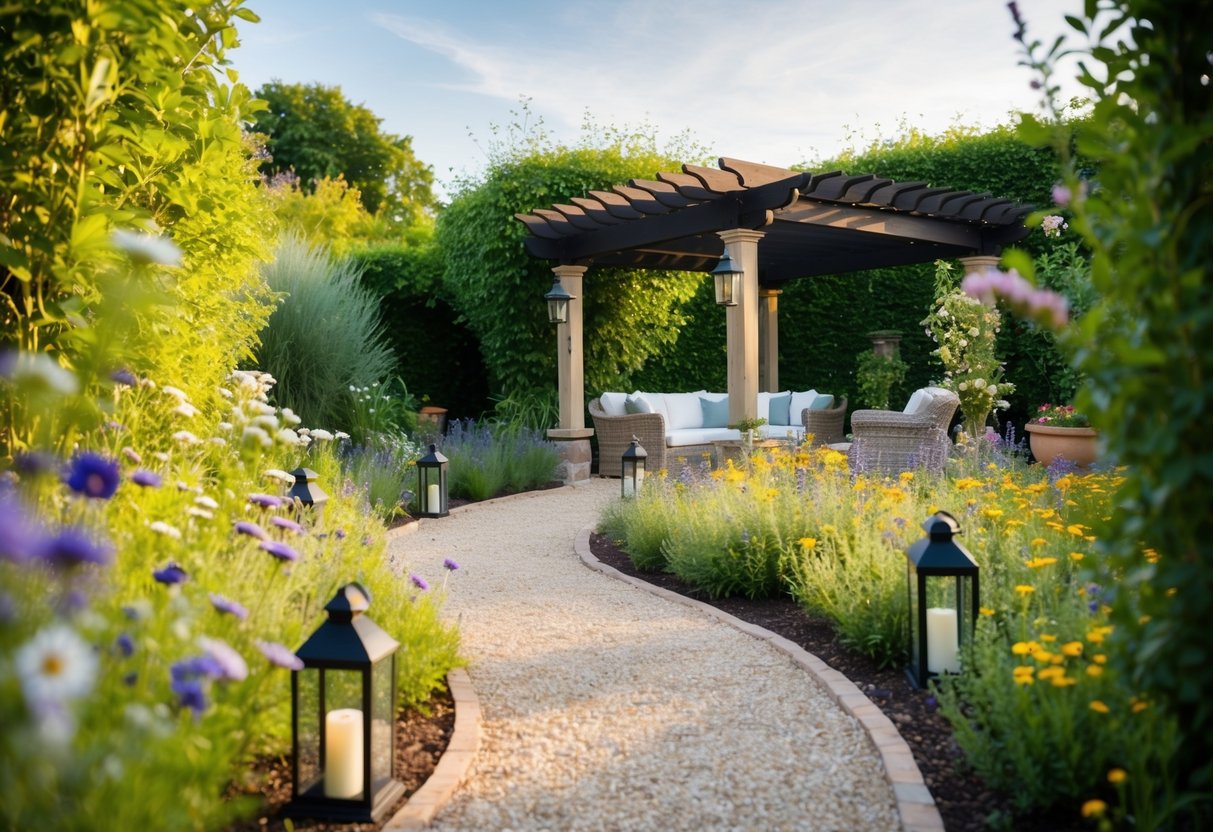
Incorporating Plants and Greenery
Integrating green elements into garden paths not only enhances beauty but contributes to a sustainable, lively environment. Key plant choices like lavender, echinacea, and flowering ground cover add texture and color.
Incorporating Ground Cover and Flowering Plants
Ground cover plants are essential for filling gaps between stepping stones or paving. They create a lush carpet that softens paths and reduces erosion. Popular options include creeping thyme and moss, which thrive in shaded or partial sunlight areas.
Flowering plants like wild chamomile add splashes of color and irresistible fragrance. Select varieties that require minimal maintenance and can withstand foot traffic. Regular trimming and monitoring are essential to prevent overgrowth and maintain a tidy appearance.
Choosing the right combination of ground cover and flowering plants creates an inviting, vibrant walkway. The mixture of textures and colors complements the garden’s natural aesthetics while supporting local wildlife. Native species often adapt well to local conditions, reducing the need for extra care.
Choosing Plants like Lavender and Echinacea
Lavender and echinacea are excellent choices for rustic paths. Their vibrant blooms and fragrance transform paths into sensory experiences.
Lavender thrives in sunny spots with well-drained soil. Its aromatic scent and purple flowers attract pollinators while its resilience to drought makes it an ideal choice for low-maintenance gardens. Regular pruning ensures it retains structure and vigor.
Echinacea, also known as coneflower, is hardy and resistant to pests. Its bold colors and towering form add a vertical dimension to garden paths. Echinacea prefers full sun and adapts well to various soil types. Integrating these plants requires a strategic layout, ensuring each type complements and enhances the other.
Building Specialty Paths
Specialty paths can enhance the visual appeal of a garden, adding unique character and functionality. Exploring different designs like circular or elevated options can inspire you to create a beautiful garden path tailored to your landscape.
Creating a Circular or Curved Pathway
A circular or curved pathway can provide a sense of flow and movement in garden spaces. These pathways guide visitors naturally through the environment and can be designed to emphasize specific garden features or create an intimate setting. Building a curved path typically involves outlining a gentle arc or circle and then choosing materials like gravel, flagstone, or bricks.
Beginners might find it helpful to use a rope or hose to set the curve’s shape before finalizing the design. Calculating the correct radius and smoothness is crucial to ensure that the pathway appears harmonious and blends seamlessly with the surrounding plants and structures. In addition, edging materials, such as metal or stone, can be used to define the path and prevent materials from spreading.
Elevated Walkways and Raised Boardwalks
Elevated walkways and raised boardwalks offer practical and aesthetic benefits, particularly in gardens with varying elevations or near water features. They help protect sensitive plants by keeping foot traffic off the ground and allow water to drain effectively. Constructing a raised boardwalk involves using durable materials like treated wood, composite, or metal.
Designing these pathways requires attention to the garden’s contours and drainage needs. Elevated walkways can be crafted to navigate over ponds or marshy areas, providing striking vantage points or seamlessly connecting different sections of a garden. Safety features, such as non-slip surfaces and handrails, can enhance usability and ensure a secure passage for visitors.
Decorative Elements and Features
Charming garden paths often feature elements that enhance their natural appeal. Adding rustic stepping stones and integrating garden structures like arbors or archways can significantly elevate the aesthetic of any garden path.
Accessorizing with Rustic Stepping Stones
Rustic stepping stones can add character to a garden path. They blend well with the natural environment and offer a charming, tactile experience underfoot. Commonly made from materials like slate, granite, or reclaimed wood, these stones can vary in shape and size to create a more organic appearance.
An uneven pattern can make paths look less formal and more integrated with the surroundings. Ideally spaced for a comfortable stride, these stones guide visitors along the path while doubling as functional elements in the design.
Regular maintenance like removing moss or cleaning dirt helps preserve their rustic look. These stones can reflect a thematic tie to adjacent elements, such as wooden fences or metal garden sculptures, contributing to a cohesive garden design.
Integrating a Garden Arbor or Archway
An arbor or archway can serve as a focal point in garden path designs, providing both structure and visual interest. These features can define entry points or highlight transitions between different segments of the garden. Whether made of wood, metal, or wrought iron, they blend well with various garden styles.
Planting climbing vines can enhance their rustic appeal, offering shade or fragrance as the garden evolves through the seasons. Arbors and archways can also frame picturesque views, enticing visitors further into the garden. Choosing an appropriate design involves considering the path’s width and the overall space available, ensuring a harmonious fit with surrounding garden elements.